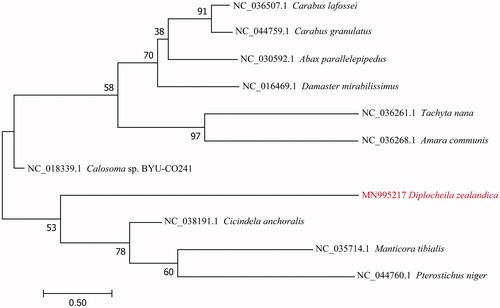Abstract
Diplocheila zealandica Redtenbacher is a natural enemy of aphids and larva of lepidoptera worldwide. Here, we first report the characterization of mitochondrial genome of D. zealandica in Diplocheila and its phylogenetic position. The complete mitogenome (GenBank accession number: MN995217) of D. zealandica from Henan Province consisted of a circular DNA molecule of 16,190 bp (with 21.66% G + C content), which comprised 13 protein-coding genes (PCGs), and 22 tRNA, and two rRNA genes. PCGs had typical ATN (Met) initiation codons and were terminated by typical TAN stop codons.
Diplocheila zealandica Redtenbacher is a natural enemy of aphids and larva of lepidoptera worldwide. Here, we first report the characterization and phylogenetic studies of the complete mitogenome of D. zealandica in Diplocheila.
Samples of adult D. zealandica (GYU-20190903-001) were obtained from Jingziguan Town (E 111.026°, N 33.244°), Xichuan County, Nanyang City, Henan Province, China on 3 September 2019. Genomic DNA was isolated and fragmented to build a genomic library of the approximate insert size 350 bp that was sequenced (paired end 2 × 150 bp) using an Illumina HiSeq 4000 (Illumina, Inc., San Diego, CA, USA). We obtained 65,749,062 reads of raw data and 65,630,762 reads of high-quality, clean data (99.82%) cleaned by cutadapt version 1.9.1 (https://github.com/marcelm/cutadapt/) (Martin Citation2011). The mitochondrial genome was assembled de novo with Velvet version 1.2.10 (https://github.com/dzerbino/velvet/) (Zerbino and Birney Citation2008), gapfilled with SSPACE version 3.0 (Boetzer et al. Citation2011) and GapFiller version 1.1 (Boetzer and Pirovano Citation2012).
The mitogenome of D. zealandica consists of a 16,190 bp circular DNA molecule (GenBank accession number: MN995217), with 40.49% A, 37.85% T, 12.36% C, and 9.30% G, which has an A/T bias (21.66% C + G content). The AT- and GC-skews of the major strands of the mitogenome were calculated to be approximately 0.0337 and 0.1415, respectively. The length of the A/T-rich region in the mitogenome is 1342 bp, with 84.34% A + T content, and is located between the srRNA and tRNA-Ile.
The order and orientation of the functional areas of the D. zealandica mitogenome are identical to those in the Tenebrio obscurus, Zophobas atratus, and Rhyzopertha dominica mitogenome (Bai et al. Citation2018, Citation2019; Ouyang et al. Citation2019). The mitogenome of D. zealandica contained 13 protein-coding genes (PCGs), and 22 tRNA, and two rRNA genes. All 13 PCGs had typical ATN (Met) start codons and TAN stop codons; atp8 and nad1 had ATA as a start codon, nad3, nad5, nad4l, nad6, nad2, and cox1 had ATT as a start codon, and cox2, atp6, cox3, nad4, and cob had ATG as a start codon. From these, atp8, atp6, cox3, nad4, nad6, cob, and nad2 had a TAA stop codon, nad1 had a TAG stop codon, cox1, cox2, nad3, nad4l, and nad5 had an incomplete stop codon consisting of a T−, which was completed by the addition of 3’A nucleotides to the resulting mRNA. The 22 tRNA genes were interspersed throughout the coding region and ranged from 65 (trnC, trnI, trnT, trnN, trnR, and trnA) to 72 bp (trnV) in length. lrRNA and srRNA were 1278 and 788 bp long, respectively.
To validate the phylogenetic position of D. zealandica, the mitogenome DNA sequences from 11 species of Carabidae were used to construct a phylogenetic tree by the Maximum-Likelihood method using the MEGA 7 software (Kumar et al. Citation2016) (). In conclusion, our study provides information of the mitogenome of D. zealandica, which will be useful for molecular identification and phylogenetic studies.
Disclosure statement
No potential conflict of interest was reported by the author(s).
Additional information
Funding
References
- Bai Y, Li C, Yang M, Liang S. 2018. Complete mitochondrial genome of the dark mealworm Tenebrio obscurus Fabricius (Insecta: Coleoptera: Tenebrionidae). Mitochondrial DNA B. 3(1):171–172.
- Bai Y, Wang H, Li G, Luo J, Liang S, Li C. 2019. Complete mitochondrial genome of the super mealworm Zophobas atratus (Fab.) (Insecta: Coleoptera: Tenebrionidae). Mitochondrial DNA B. 4(1):1300–1301.
- Boetzer M, Henkel CV, Jansen HJ, Butler D, Pirovano W. 2011. Scaffolding pre-assembled contigs using SSPACE. Bioinformatics. 27(4):578–579.
- Boetzer M, Pirovano W. 2012. Toward almost closed genomes with GapFiller. Genome Biol. 13(6):R56.
- Kumar S, Stecher G, Tamura K. 2016. MEGA7: molecular evolutionary genetics analysis version 7.0 for bigger datasets. Mol Biol Evol. 33(7):1870–1874.
- Martin M. 2011. Cutadapt removes adapter sequences from high-throughput sequencing reads. EMBnet J. 17(1):10–12.
- Ouyang B, Bai Y, Chen J, Wang J, Liang S. 2019. Characterization of the complete mitochondrial genome of lesser grain borer Rhyzopertha dominica Fabricius (Insecta: Coleoptera: Bostrichidae) from Jingziguan. Mitochondrial DNA B. 4(2):3952–3953.
- Zerbino DR, Birney E. 2008. Velvet: algorithms for de novo short read assembly using de Bruijn graphs. Genome Res. 18(5):821–829.

